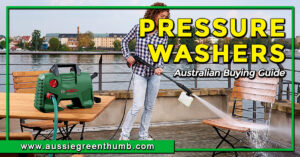If your lawn has seen better days, don’t worry. Like every problem in the garden, history has a tool for it. Traditional lawn rollers might seem outdated, but sometimes, the best solution isn’t tech and flashy gadgets, it’s just honest graft.
If you’re unsure how to use a lawn roller though, or whether you even need one, read on. We’ve got reviews of the best lawn rollers on the market, as well as a comprehensive guide on using them to their fullest
More...
Top Pick

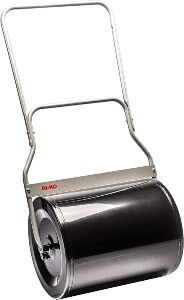
Best Lawn Rollers in Australia
Product | Our Rating | Price | |
|---|---|---|---|
1. AL-KO Hobby GW50 Lawn Roller | 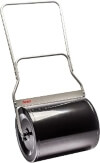 |  | |
2. Black Garden Lawn 68L Grass Roller | 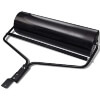 |
Lawn Rollers Buying Guide
What is a Lawn Roller?
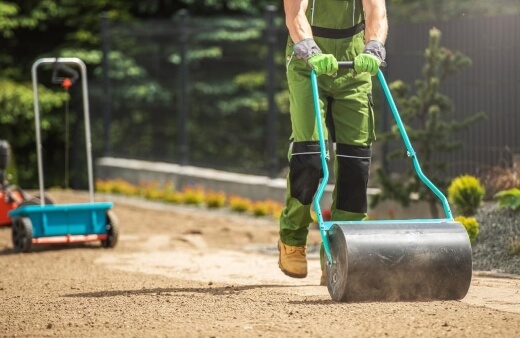
Lawn rollers are designed to flatten out lawns, and maintain pristine turf. While they might seem old-fashioned they are still used regularly today by professional lawn care experts, and enthusiastic gardeners.
Lawn rollers are rolling barrels, with basic handles, and do one very simple job; flatten. The heavyweight tools make light work of hillocks and divots, which can easily be filled with sand and compacted down into a flat, even surface for re-sowing seed.
When do you need a lawn roller?
Lawn rollers have two primary uses, but can also be a helpful hack for perfect stripes if you’ve got a budget lawnmower. The main reasons to use a lawn roller are for seeding new lawns and repairing bumps and divots in old ones.
When seeding new lawns, most people will simply wet the surface to create fuller adhesion between the seed and the soil. The problem with this is that it can open up the bare soil structure and cause bumps where the soil was unevenly compacted.
Lawns need some level of compaction so that grass seed can grow into a tough matt, without being pulled up from loose soil. By pre-rolling the bare soil, you create even compaction, so when you water the seed later the soil stays completely level.
There are all sorts of reasons why existing lawns get bumps and divots, from kids to wildlife. Turf rollers are perfect for fixing these imperfections.
What to Consider When Buying a Lawn Roller
Weight
Manual lawn rollers should be between 50 and 70kg. Any heavier can compact soil. For tow bar lawn rollers, designed to be used on the back of quad bikes or lawn tractors, they should be significantly heavier – around 150-200kg when filled.
The reason for the discrepancy is speed, and support. Tow behind lawn rollers are supported and towed by other vehicles, meaning they make contact with the soil for less time.
These are perfect for golf course or sports field maintenance, but far too big for domestic use. Domestic lawn rollers are heavy objects, and take some serious graft to move.
Any heavier than 70kg is just too much for most people, while less than 50kg will barely make (or fix) a dent.
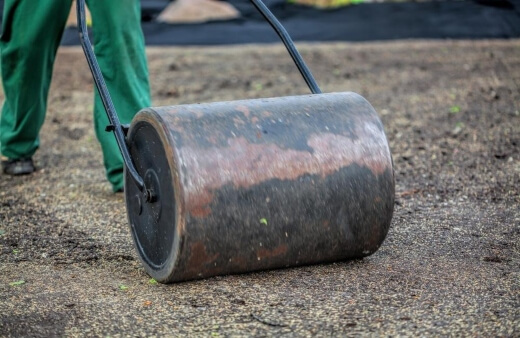
Size
Two factors should determine the size of lawn roller you choose; storage and speed. Narrow lawn rollers take longer to do their job, while larger lawn rollers are harder to store.
Like all tools, everything is relative too. If a 60cm wide lawn roller weighs 50kg, it will do a worse job than a 50cm lawn roller of the same weight.


Get Your Free Guide:
Master Growing Australian Natives eBook
A Must Have Complete Guide for Every Australian Garden
Get Your Free Guide:
Master Growing Australian Natives eBook
A Must Have Complete Guide for Every Australian Garden
Either choose a 50cm, 50kg model, or a 60cm, 60kg model. It’s not an exact science, but the width and weight have a clear relationship to the quality of the outcome.
Scraper Bar
99% of lawn rollers are sold with scraper bars. In reality, scraper bars aren’t actually necessary if you’re rolling turf on a dry day (which is the only time to do it). However, they serve an additional purpose, as well as removing mud and dirt from the roller as you go.
Roller bars add stability to rollers, which are often built with hollow turned steel handles. The added support of the roller bars help these tools to cope with the strain on the handles.
Different Types of Lawn Rollers
Without going to an antique shop, you’re very unlikely to find a solid, or thick skinned lawn roller, like the traditional tools used on cricket pitches. They’re industrial and so heavy that they’re almost impossible to deliver.
So, when it comes to modern lawn rollers, what separates them from each other?
Plastic vs metal lawn rollers
Plastic lawn rollers are better than metal lawn rollers. There, I said it. Metal lawn rollers are hollow, and thin skinned these days, making them very susceptible to denting and damage.
If filled with water they can rust from the inside out, and when filled with sand they are incredibly hard to empty. Plastic lawn rollers are built with thicker walls, are easy to empty, and usually have a double spout, meaning water drains fast and thoroughly.
The other advantage of plastic lawn rollers is that they scratch rather than dent when they hit an obstacle, which helps them keep their shape for longer.
Solid vs water filled lawn rollers
Solid lawn rollers are significantly better tools than filled lawn rollers. Filled lawn rollers are supplied as hollow barrels, which you then fill with water or sand to add weight.
The solid metal tools are heavier, and much more durable, but very difficult to store, and hard to move around when not in use. So, despite solid rollers being better tools, most gardeners will be better off with hollow turf rollers.
How to Use a Lawn Roller
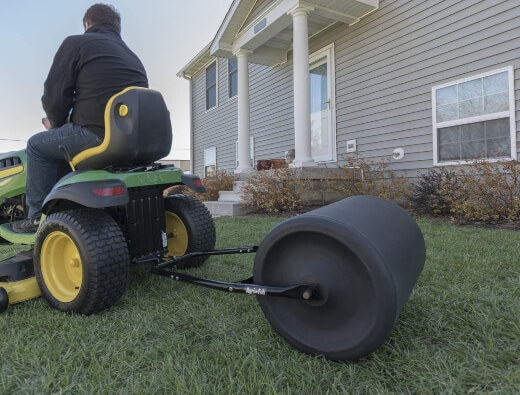
Source: amazon
lawn rollers are heavy, it’s how they work, so let’s not get caught up in the idea that you can use a lightweight tool to do this job. Flattening lawns and levelling ground involves compacting the soil. For most garden tasks, that’s a big no-no. For lawns, it’s essential.
So, get comfortable clothes on, and get set for a workout.
Using a lawn roller to lay new lawns, turf rolls, or grass seed:
- Start by raking over the soil to a visibly even layer.
- Push or pull (whatever is most comfortable) the lawn roller over the area until it is even and mostly compacted.
- Water the ground, and let it sit for 24 hours.
- Fill in any divots caused by watering. Overfill these holes.
- Repeat the turf roller over the whole area.
- Gently rake the surface with a leaf rake to loosen a fine layer on top of the soil.
- Sow grass seed according to instructions (different seeds need different densities), or lay your turf rolls.
- Roll the seed into the dry soil for full contact.
- Water thoroughly, then continue watering each day until the lawn is established (4-6 weeks).
Repair bumps in lawns using a lawn roller:
- Loosen any upwards bumps with a hand fork.
- Roll over with a lawn roller a few times, until flat.
- Sow grass seed on the repaired patches.
- Water patches well for a few weeks until they germinate.
Using a lawn roller to repair divots in lawns:
- Loosen the soil inside any divots in your lawn to improve adhesion.
- Mix 50% garden soil and 50% garden sand in a bucket, then overfill every divot so it is slightly mounded.
- Roll over with a turf roller until the divots are flat and flush with the rest of the ground.
- Sow grass seed onto the repaired patches.
- Water each patch, and continue watering until the lawn has re-established.
Lawn Roller Reviews
1. AL-KO Hobby GW50 Lawn Roller

Source: amazon
The AK-LO Hobby GW50 Lawn Roller is one of the best-designed lawn rollers I’ve come across in a while. Its durable rubberised plastic barrel is super easy to use and runs smoothly over most surfaces.
The scraper bar is a generous width and reduces fallen dirt. And, while the handle is designed for stability, it’s still easy to fold away and store.
It’s only 50cm wide, making your job slightly more arduous, with more passes to get the right levels, but, for home gardeners, the smaller barrel is probably a good thing, as it's far easier to store, and takes up much less garage space.
Pros
Cons
2. Black Garden Lawn 68L Grass Roller

Source: kingswarehouse
This simple tow-behind lawn roller is good for a gentler approach, but it’s far too narrow to make a real impact on tough divots and bumps in lawns.
Where it excels, is in the alternative use cases. Like striped lawns and ongoing levelling. If you’re regularly using lawn rollers to get perfect finishes on lawns, this is a useful addition to a lawn tractor, but we definitely wouldn’t suggest it as a start point for brand new lawns.
Pros
Cons
Lawn Roller Top Picks for 2025
Best Lawn Roller - Our Top Pick


Source: amazon
AL-KO aren’t exactly a household name, but if you’ve ever had the pleasure of their garden tools, you’ll know just how effective they can be. AL-KO’s tool range is well designed, and only really held back by their lack of marketing.
If you’re prepared to take a leap of faith into their products, the tough and durable AL-KO Lawn Roller is by far the best on the market right now, thanks to its well-considered handlebars, hardy scraper bar, and impact resistant barrel.
Lawn Roller Frequently Asked Questions
Should I use a roller on new turf?
Never, ever, use a lawn roller on newly laid turf. Turf needs time to establish before being walked on, or pressurised at all. When laying turf it’s important to agitate the soil underneath to allow roots to properly connect to the soil. By rolling over, you compact that surface layer.
How heavy should a lawn roller be?
There is no ideal weight for a turf roller, as weight is relative to size. For every 10cm wide, about 10kg of pressure is ideal. The wider the roller, the heavier it should be. A standard 60cm roller should be 60-70kg for proper compaction.
Should I roll my bumpy lawn?
Yes and no. Rolling bumpy lawns helps revive their surface and prevents raised areas from losing water. However, it’s essential that you loosen any raised soil, and roll over afterward.
Simply rolling raised soil flat can over-compact it, and create a solid patch of ground where roots can’t establish.
What can I use instead of a lawn roller?
For seeding lawns, the best alternative to a turf roller is water and hard work. For repairing bumps and divots, the best alternative to a turf roller is a hand fork and your feet.
Lawns need compacted soil to keep their form, but also like loose surface soil while they establish. If you don’t have a turf roller, or can’t get hold of one, simply walk up and down, compacting the soil with your feet, then loosening the surface gently with a sprung rake.
For more product reviews on tools you may need for your lawn, see our list below:
Wrapping Up Our Lawn Rollers Guide
Professional and DIY gardeners can both make use of lawn rollers, but these tools have got a bad name for themselves. The reality is that there is plenty of terrible advice out there about how to use a turf roller which makes it sound simple, which has led to gardeners blaming lawn rollers, rather than method, for their problems.
Turf rollers are part of a solution, not the whole thing. They should be used in conjunction with proper irrigation, and the best rakes you can find to create a good mix of compaction, and loose surface soil.
Don’t overdo it, or you’ll create a barren, bog where grass can’t grow. But, if you get it right, the best lawn rollers will completely renew your outdoor space.
Published on August 30, 2022 by Gary Clarke
Last Updated on December 27, 2025


